Politeness Theory
Concept of Face in Politeness:
The wish of every member of a community to guard his or her face from possible damage through social interferences
- Positive face: the wish or desire to gain approval of others.
- Negative face: the wish to be unimpeded by others in one’s actions.
Politeness Strategies:
- Positive Politeness - minimize the threat to the hearer’s positive face (where audience knows each other fairly well)
- You look sad. Can I do anything?
- Offer or promise (If you wash the dishes, I’ll vacuum the floor.)
- Negative Politeness - minimize threar to hearer’s negative face
- Apologetic
- Pessimistic
- Bald-on record - direct speech like giving advice, used when close relationship between speaker and hearer
- Your headlights are on!
- Leave it, I’ll clean up later.
- Off-record (indirect) - speaker tries to speak in a way to not impose on the hearer or gives a better chance for the hearer to be helpful and generous
Examples: (Im): Grab the chair for the speaker (Po): Do you have a free chair over there?
(Im) Can you lend me a thousand dollars? (Po) I’m sorry; it’s a lot to ask, but can you lend me a thousand dollars?
Speaker: Are you going out? Hearer : Yes. (Im) Yes, but I’ll come home early. (Po)
You couldn’t find your way to lending me a thousand dollars, could you? So I suppose some help is out of the question, then?

Style-conditioned LM: Predict p(x | a)
Text-style Transfer: Predict p(x | a, x’)
Papers
- A computational approach to politeness with application to social factors
- Delete, Retrieve, Generate: a Simple Approach to Sentiment and Style Transfer
- Politeness Transfer: A Tag and Generate Approach
- Style Transfer Through Back-Translation
- Facilitating the Communication of Politeness through Fine-Grained Paraphrasing
- Polite Dialogue Generation Without Parallel Data
- Controlling Politeness in Neural Machine Translation via Side Constraints
- Style Transfer in Text: Exploration and Evaluation
- Style Transfer from Non-Parallel Text by Cross-Alignment
- Interpreting Neural Networks to Improve Politeness Comprehension
- Deep Learning for Text Style Transfer: A Survey
Delete, Retrieve, Generate: a Simple Approach to Sentiment and Style Transfer
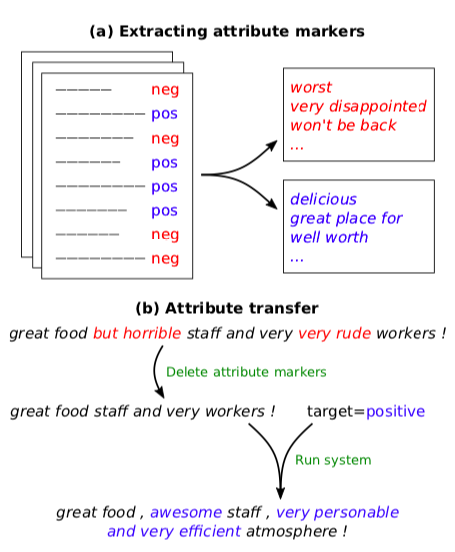
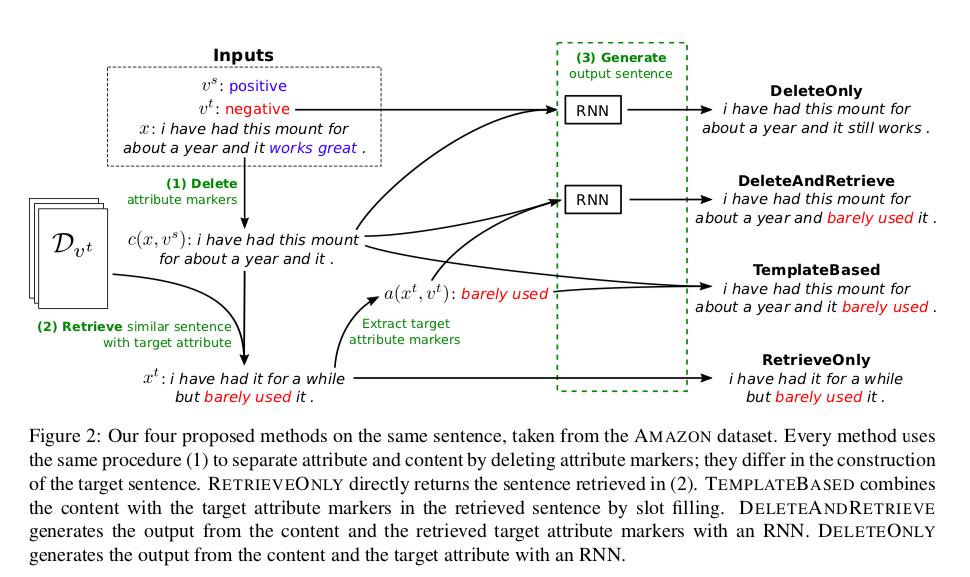
- Non-parallel corpus
- Prototype-Editing method (Std steps)
- Detect attribute markers of a in the input sentence x, and delete them, resulting in a content-only sentence (n-gram based heuristic)
- Retrieve candidate attribute markers with similar content and carrying the desired attribute a′
- (Generate) Infill the sentence by adding new attribute markers and make sure the generated sentence is fluent
** Note that: DeleteOnly and DeleteAndRetrieve need ML training and during training, target attributes are not available
DeleteOnly Training:

DeleteAndRetrieve Training:

It uses denoising auto-encoder to prevent trivial solutions.
- YELP, Amazon Reviews (Sentiment Transfer), Captions (Factual to Humor/ Romance)
Politeness Transfer: A Tag and Generate Approach

- Task: either generate samples of X1 in S2 given X1 OR X2 in S1 given X2
- Non-Parallel Corpora (not corupus) - for 2 styles
- Prototype-Editing method
- Key differences:
- No DELETE
- More interpretable intermediate representation
- “Neutral” to Specific-Style Transfer
- Method
- Add-tagger for Neutral -> Style (Politeness/ Caption-Style transfer)

- Replace-tagger for Style1 -> Style2 (Sentiment-transfer)

- Generation

- Add-tagger for Neutral -> Style (Politeness/ Caption-Style transfer)
- Datasets: Enron (Politeness), Gender, Political datasets
- Used Transformers
A computational approach to politeness with application to social factors
- Introduced politeness strategies using computational framework
- SVM-based classifiers: BOW (only unigrams), Linguistically informed (LING)
- Introduced Stanford Politeness Corpus (Annotated Wiki, Stack Exchange datasets)
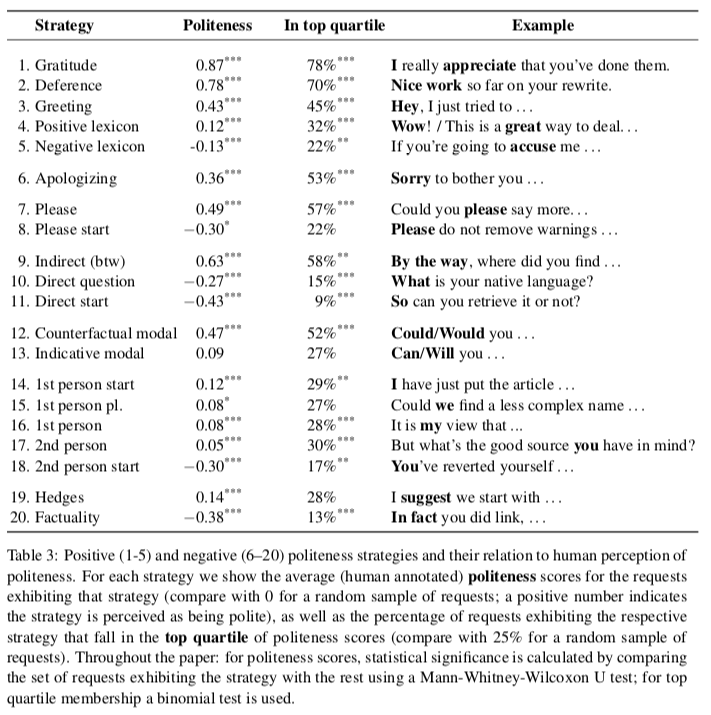
Interpreting Neural Networks to Improve Politeness Comprehension
- CNN-based classifier
Polite Dialogue Generation Without Parallel Data
-
Politeness Classifier: Bi-LSTM + CNN classifier
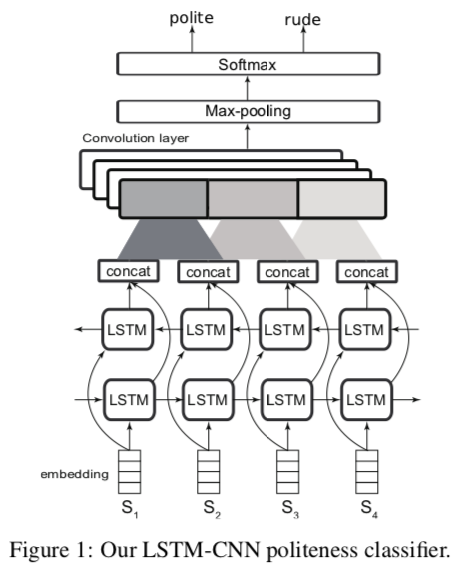
- Baseline(Seq2Seq): 2-layer LSTM-RNN encoder + 4-layer LSTM-RNN decoder
- Fusion model: final output as linear combination of Seq2Seq & Polite-LM
- Polite-LM: 2-layer LSTM-RNN
- Drawbacks: conversation not attended; politeness not used during training
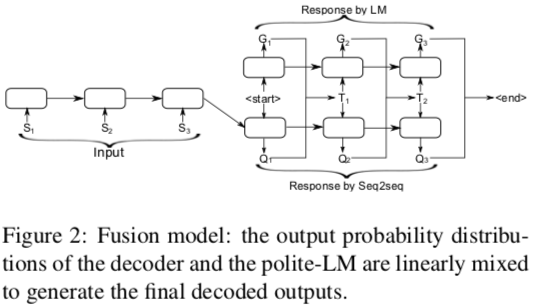
- Label-Fine-Tuning model
- Borrowed from Spithourakis et al. (2016)
- Politeness label prepended to trainable word embedding; embedding scaled acc to politeness score
- During training, politeness score received from Politeness Classifier
- During inference, we choose politeness score as per application
- Label serves as prior for style, source utterance for content
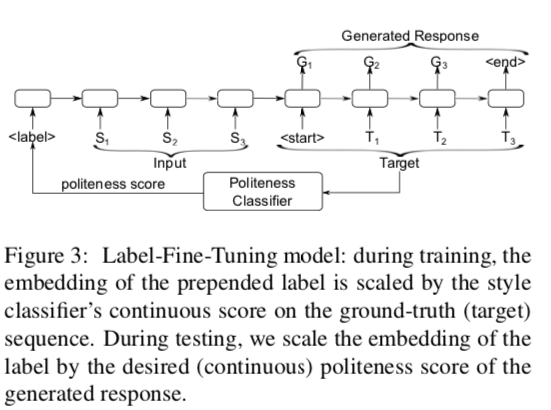
- Polite RL model
- Borrowed from Paulus et al. (2018)
- Loss is combination of MLE-based (teacher-forcing) and RL-based (politeness score of classifier)


- Stanford Politeness Corpus
Style Transfer Through Back-Translation
- Non-Parallel Corpora
- Based on hypothesis by Rabinovich et al. (2016) that latent code z obtained through back-translation will generate a sentence devoid of style attributes (like author’s traits)
- z(French) is used to generate English sentence in different styles (e.g. Republican/ Democrat)
- Decoders: Bi-LSTM, Classifier: CNN-based
- Yelp (Gender), Yelp Reviews, Facebook-comments of US Senate & House (Political slant)

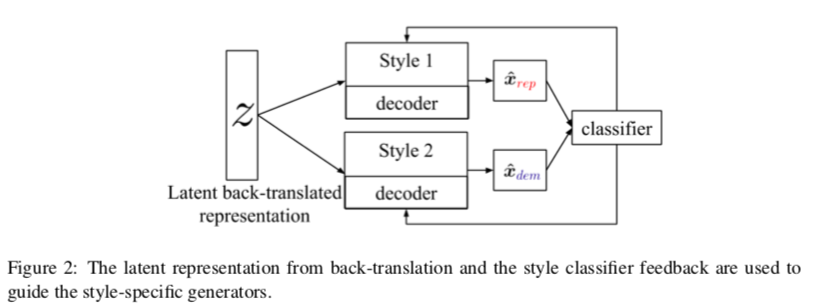
Controlling Politeness in Neural Machine Translation via Side Constraints
- Politeness understood as T-V distinction (i.e. to address second person informally/ formally)
- English - no distinction (you)
- Hindi (tu-aap), Romanian (tu-dumneavoastră), German (tu-vos)
- <T> or <V> added as extra source token to impose side-constraint
- Parallel Corpus: OpenSubtitles2013
Facilitating the Communication of Politeness through Fine-Grained Paraphrasing
Style Transfer in Text: Exploration and Evaluation

- Encoder: GRU
- Multi-Decoder Model
- ~ Autoencoders with multiple decoders (for different styles)
- Disentangle Style from Content
- First eqn minimizes NLL of classifying style label of x given the representation by the encoder (M-samples, N-styles)
- Second eqn makes the classifier unable to identify style of x by minimizing the negative entropy of the predicted style labels. Together they disentangle style from content in adversarial way
- Third eqn gives the decoding loss function for generating outputs in each style (Seq2Seq loss)




- Style-Embedding Model
- E: (N X ds) where N = #styles, ds = dim(style)
- Style embeddings (E) now additionally fed

Parallel Data Augmentation for Formality Style Transfer
- Back-Translation
- Formality discrimination
- Use Google translate for informal -> formal and then pass it through a CNN
- Keep only the pairs which largely improve the formality:

- Multi-task transfer
- Pass through Grammatical Error Correction (Ge et al. 2019)
- Claim/ observation: Informal=ungrammatical, formal=grammatical
Discussion on Interesting Ideas:
-
Neural Editor for Prototype Editing (Generating Sentences by Editing Prototypes)
The motivation is that sentences from the corpus provide a high quality starting point: they are grammatical, naturally diverse, and exhibit no bias to- wards shortness or vagueness. The attention mechanism (Bahdanau et al., 2015) of the neural editor strongly biases the generation towards the prototype, and therefore it needs to solve a much easier problem than generating from scratch. - Better evaluation metrics
- Survey done by Reformulating Unsupervised Style Transfer as Paraphrase Generation
- Transfer Accuracy: used RoBERTa-large fine-tuning instead of 1-layer CNN
- Semantic Similarity: replaced n-gram metrics like BLEU with subword embedding-based SIM model of Weiting et al. (2019)
- Fluency: replaced perplexity with accuracy of RoBERTa-large classifier trained on CoLA corpus
- No need of separating style and content
- Style Transformer: Unpaired Text Style Transfer without Disentangled Latent Representation
- Another motivation: The recurrent neural network (RNN) based encoder and decoder, mediated by the latent representation, cannot well deal with the issue of the long-term dependency, resulting in poor preservation of non-stylistic semantic content.
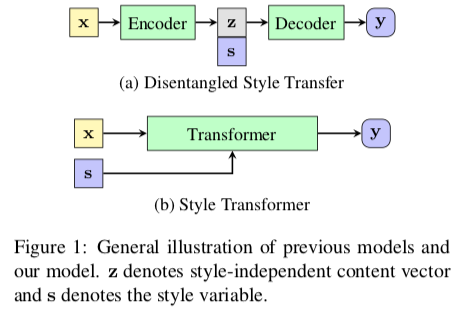
- Another motivation: The recurrent neural network (RNN) based encoder and decoder, mediated by the latent representation, cannot well deal with the issue of the long-term dependency, resulting in poor preservation of non-stylistic semantic content.
- Multiple-attribute text rewriting
- Style Transformer: Unpaired Text Style Transfer without Disentangled Latent Representation
- [Paragraph-level] Contextual Text Style Transfer
- Approached borrowed from (Mikolov and Zweig, 2012; Tang et al., 2016)

- Approached borrowed from (Mikolov and Zweig, 2012; Tang et al., 2016)
References
- Ge et al. (2019) Automatic grammatical error correction for sequence-to-sequence text generation
- Weiting et al. (2019) Beyond BLEU: Training Neural Machine Translation with Semantic Similarity